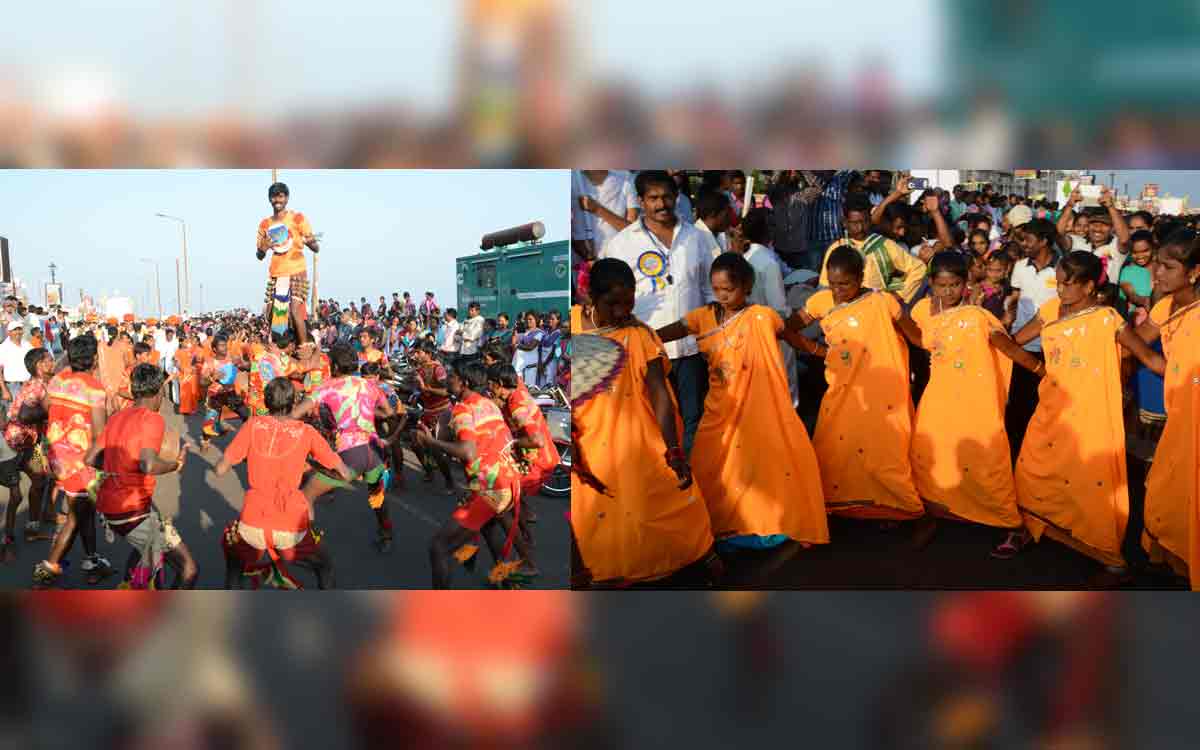

Known as a state with great cultural diversity, Andhra Pradesh is indeed a land of rich heritage. The local folk and tribal dances here are performed to express joy during the arrival of seasons, the birth of a child, weddings, and festivals. Often, they serve as the gleaming testimonies of our culture and the practices of the region. Closer home in the northern parts of the state, several folk and tribal dance forms rose to prominence over the years. To celebrate this rural indigeneity of Andhra Pradesh, we are here with a list of indigenous dance forms found near Visakhapatnam.
Village festivals often see the performance of the folk dance Tappetagullu. Performed in honour of the village deity, songs are sung in praise of the ten incarnations of Lord Vishnu, including stories from Ramayana and Mahabharata. Dancers, who are often men, hang unique metal drums around their necks and produce beats with movements. They often wear colourful shirts, a turban, and a loincloth and are adorned with bells. The dance is performed with vigour, rhythm, and tempo, punctuated with displays of rare acrobatic skills and the formation of human pyramids while dancing. Involving immense muscle power, this folk dance of Andhra Pradesh is one of the popular dance forms in the districts of Srikakulam, Vizianagaram, and Visakhapatnam.
Often performed during the nine-day celebrations of Vinayaka Chavithi and Dasara, these are narratives from the great epics of Ramayana, Mahabharata, and the Bhagavatam. With the name derived from ‘Hari’ referring to Lord Vishnu and ‘Katha’ meaning story, this art form is also known as Katha Kaalakshepa (spending time with a story) in some parts of the state. Performed by artists who are called Haridasu, the stories are usually in the form of songs and poetry to which they dance as they play the musical instruments too. Stories are skillfully told with anecdotes that make them interesting. Other than mythology, social and political issues are commented upon as well. As per Hindu mythology, the first Harikatha was sung by sage Narada in praise of Lord Vishnu, and this inspires the attire of the Haridasu.
This distinct folk art form of storytelling used to be a great pastime in villages and is still popular during Dussehra and Sankranthi festivals. It involves the performance of the main artist or ‘Kathakudu’ who narrates stories of Indian mythology while playing music and dancing to it. Co-artists accompanied with drums, anecdotes, dance, and songs add to the experience. Humour is brought in by the ‘Hasyaka’ while the ‘Rajkiya’ talks of politics and social issues. Involving prayer, poetry, music, and drama, Burrakatha derives its name from ‘Burra’ which comes from ‘Tambura’, the precision instrument played by the lead artist. Katha means tale, as the art form truly tells stories of social change and moral values too. Performers of a Burrakatha wear kurtas and tight pyjamas in vibrant hues. Co artists play the ‘gummeta’, which is similar to a drum.
Using dancing as a medium to describe a typical day in a fisherman’s life, the Jalaari Nrityam (dance) was recently created by Sampath Kumar. So popular has the dance style become, that it is now recognised by the fisherfolk as their own. Combining many of the existing folk dance forms, dancers dress traditionally in ‘panchalu’, ‘ganji’ and wear long hats. Men use fishermen’s nets as props, while the women use cane baskets.
The fascinating performance of Pulivesham is often enacted during festivals in villages and towns. Dancers painted and dressed as tigers start by jumping and marching to the rhythm of drum beats. Also seen sporting masks and long tails, they showcase strength through acrobatic skills in dance. The hunter enters the scene and wounds the tiger. This marks the start of an energetic encounter between the two, ending with the tiger falling dead. Performed with the backdrop of musical instruments, the costume, and makeup of the Pulivesham are its highlight. The person who plays the tiger paints himself in yellow paint with bold black stripes. The expressions and dance moves make Pulivesham popular entertainment. While the dance has little religious significance and showcases triumph, it is believed that many sick people often take a vow that they would take the role of the tiger if they are cured.
This list of indigenous dance forms is incomplete without Dhimsa, one of the iconic tribal dances of the Visakhapatnam Agency. Dhimsa is predominantly performed by the ethnic tribal Porja women of the Araku Valley. This expressive dance is dominated by the movements of the feet and hands of the group performing the dance in a circle. Though it can be performed by men and women, young and old, typically around 15-20 women carry the act. They bedeck themselves with ornate jewellery and dance in tune with the drum beats. The performers sway in rhythm by forming mesmerizing circles and half circles.
The Indian Institute of Petroleum and Energy (IIPE), Visakhapatnam, is set to become home to…
A major administrative revamp is on the horizon for Visakhapatnam, as the Greater Visakhapatnam Municipal…
The weekend is finally here, which means it is time for entertainment! No matter what…
Once upon a time, kids spent their free time chasing each other outside, climbing trees,…
If Vizag is called the city of destiny, then it means the people living in…
After a week-long wait, which felt like an eternity, the IPL is finally ready to…
Leave a Comment